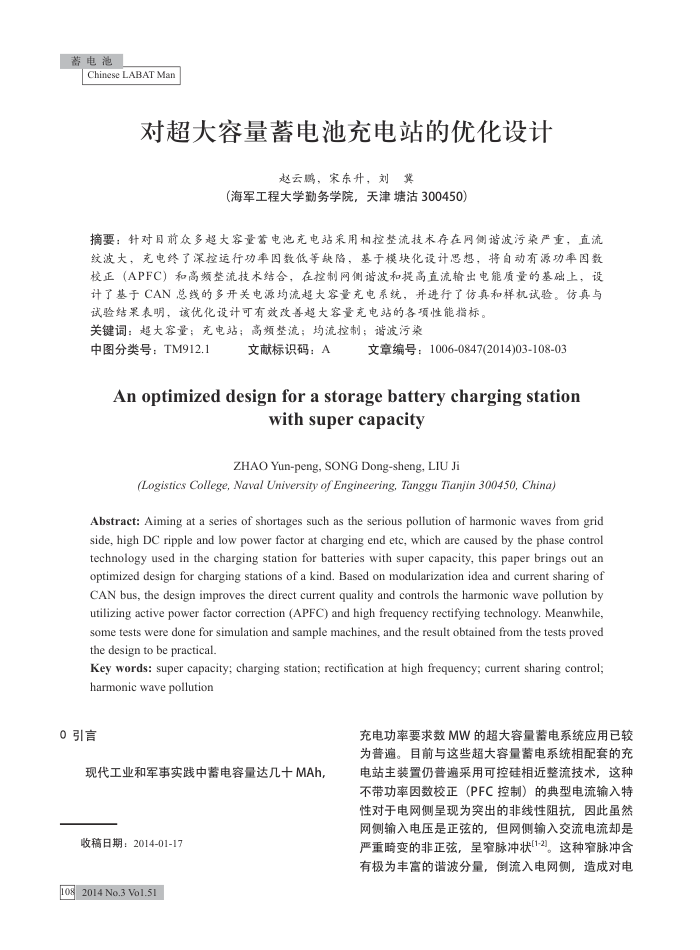您当前的位置:首页>论文资料>对超大容量蓄电池充电站的优化设计
内容简介
 蓄电池
蓄电池Chinese LABAT Man
对超大容量蓄电池充电站的优化设计
赵云鹏,宋东升,刘冀
(海军工程大学勤务学院,天津塘沽300450)
摘要:针对目前众多超大容量蓄电池充电站采用相控整流技术存在网侧谐波污染严重,直流纹波大,充电终了深控运行功率因数低等缺陷,基于模块化设计思想,将自动有源功率因数校正(APFC)和高频整流技术结合,在控制网侧谐波和提高直流输出电能质量的基础上,设计了基于CAN总线的多开关电源均流超大容量充电系统,并进行了仿真和样机试验。仿真与
试验结果表明,该优化设计可有效改善超大容量充电站的各项性能指标。关键词:超大容量;充电站;高频整流;均流控制;谐波污染
中图分类号:TM912.1
文献标识码:A
文章编号:1006-0847(2014)03-108-03
Anoptimizeddesignforastoragebatterychargingstation
withsupercapacity
ZHAO Yun-peng, SONG Dong-sheng, LIU Ji
(Logistics College, Naval University of Engineering, Tanggu Tianjin 300450, China)
Abstract: Aiming at a series of shortages such as the serious pollution of harmonic waves from grid side, high DC ripple and low power factor at charging end etc, which are caused by the phase control technology used in the charging station for batteries with super capacity, this paper brings out an optimized design for charging stations of a kind. Based on modularization idea and current sharing of CAN bus, the design improves the direct current quality and controls the harmonic wave pollution by utilizing active power factor correction (APFC) and high frequency rectifying technology. Meanwhile some tests were done for simulation and sample machines, and the result obtained from the tests proved the design to be practical.
Key words: super capacity; charging station; rectification at high frequency; current sharing control: harmonic wave pollution
0引言
现代工业和军事实践中需电容量达几十MAh
收稿日期:2014-01-17[082014 No.3 Vo1.51
充电功率要求数MW的超大容量蓄电系统应用已较为普通。目前与这些超大容量蓄电系统相配套的充电站主装置仍普遍采用可控硅相近整流技术,这种不带功率因数校正(PFC控制)的典型电流输入特性对于电网侧呈现为突出的非线性阻抗,因此然网侧输入电压是正弦的,但网侧输入交流电流却是严重畸变的非正弦,呈窄脉冲状[1-2]。这种窄脉冲含有极为丰富的谐波分量,倒流入电网侧,造成对电
上一章:VRLA蓄电池充电工艺中波谷电的利用
下一章:红丹添加剂对铅酸蓄电池性能的影响